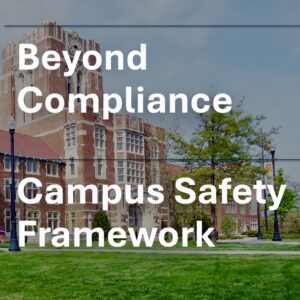Using the Jeanne Clery Act to Create a Comprehensive Campus Safety Framework
From time-to-time we see the Clery Act criticized as a bureaucratic compliance obligation rather than something that actually makes college and university campuses safer. Our view at SAFE Campuses, LLC, however, is that this is simply the wrong way to Clery (yes as a verb). It doesn’t have to be this way and our team is eager to help you get the most out of the investment you put into it to actually enhance campus safety.
 The Clery Act is designed (I know because I was there) to offer institutions a tremendous tool to help enhance campus safety. We help institutions fully realize this potential by using Clery to create an individualized, comprehensive campus safety framework. Each institution’s approach will look different but all need “the people, expertise, systems, technology, policies, and procedures to effectively manage” Clery responsibilities.
The Clery Act is designed (I know because I was there) to offer institutions a tremendous tool to help enhance campus safety. We help institutions fully realize this potential by using Clery to create an individualized, comprehensive campus safety framework. Each institution’s approach will look different but all need “the people, expertise, systems, technology, policies, and procedures to effectively manage” Clery responsibilities.
The process for gathering campus safety information and policies is ripe for enhancing campus safety and that is at the core of the model we help institutions create and implement. Our overarching theme is to bring multiple and sometimes disparate stakeholders together. While this will work to bring institutions into compliance avoiding possible penalties (which are now often significant multimillion dollar fines) the greater purpose is to actually make campus communities safer.
The Clery Act, or properly the Jeanne Clery Disclosure of Campus Security Policy and Campus Crime Statistics Act (20 USC § 1092(f), 34 CFR § 668.46), is perhaps best known for an annual disclosure of crime statistics. Many more also likely know it, even if not by name, from the timely warnings and emergency notifications campus communities receive about a wide range of safety threats. This information certainly better enables campus communities to protect themselves but it barely scratches the surface of Clery’s potential.
 Congress and the U.S. Department of Education recognized early on that campus crimes weren’t exclusively reported to campus police. This necessitated creation of a holistic process to collect crime report information from other campus officials (each designated as a “Campus Security Authority” or CSA) and local police. Over the years as a field we’ve learned many important lessons about how this should best work. One of the biggest is that this isn’t a once a year process.
Congress and the U.S. Department of Education recognized early on that campus crimes weren’t exclusively reported to campus police. This necessitated creation of a holistic process to collect crime report information from other campus officials (each designated as a “Campus Security Authority” or CSA) and local police. Over the years as a field we’ve learned many important lessons about how this should best work. One of the biggest is that this isn’t a once a year process.
Establishing a multidisciplinary committee led by a “Clery Coordinator” to collect, count, and classify this information on an ongoing basis isn’t only the best way to accomplish this but it has other benefits. It helps ensure that potential threats aren’t missed for alerts, that crime trends are analyzed in real-time, and that silos are broken down better empowering officials to work together towards actual solutions.
The Clery Act also isn’t just about crime statistics or alerts. The “Annual Security Report” (ASR), which along with the “Annual Campus Fire Safety Report” we consider to reflect a consolidated “Annual Campus Safety Report”, brings together almost all campus safety information a community member might need when they have questions. One way of looking at this is that Clery is all things campus safety, and that all things campus safety are Clery.
I’ve also written previously about how this report can have greater impact when it is simplified for the primary intended audience – prospective students and undergraduates (Education Department bureaucrats aren’t your audience). Simply republishing a full legalistic policy won’t achieve the goal, each policy must be summarized in a plain language manner.
 Institutions must have and disclose summaries of policies to address alcohol and other drugs (consistent with and alongside the Drug-Free Schools and Communities Act of 1989) and sexual misconduct (known as “VAWA” which exists as a companion to Title IX) in the ASR. It must also address, among other things, reporting crimes, the status and role of campus public safety, safety and security programming across campus, security of and access to campus facilities including student residences, emergency response and evacuation, and missing students. Congress is seriously considering legislation to add hazing to these requirements in the near future.
Institutions must have and disclose summaries of policies to address alcohol and other drugs (consistent with and alongside the Drug-Free Schools and Communities Act of 1989) and sexual misconduct (known as “VAWA” which exists as a companion to Title IX) in the ASR. It must also address, among other things, reporting crimes, the status and role of campus public safety, safety and security programming across campus, security of and access to campus facilities including student residences, emergency response and evacuation, and missing students. Congress is seriously considering legislation to add hazing to these requirements in the near future.
Effectively reflecting accurate and current information in this Clery Act campus safety “handbook” requires assembling a team something along the lines of the Knights of the Roundtable. All key officials from across campus – including campus public safety, student affairs, residence life, Greek life, athletics, human resources, and Title IX/Civil-Rights – should be brought together at least annually if not more frequently. Open consultation with student and employee stakeholders is also essential.
At SAFE Campuses, LLC we consider ourselves to be Campus Safety Consultants (not security or compliance) that use compliance with the Clery Act, Title IX, and other interrelated laws to create safer learning environments. Please write to us at info@safecampuses.biz with any questions. We’re working to create a new way to “Clery” and want you to join us.
